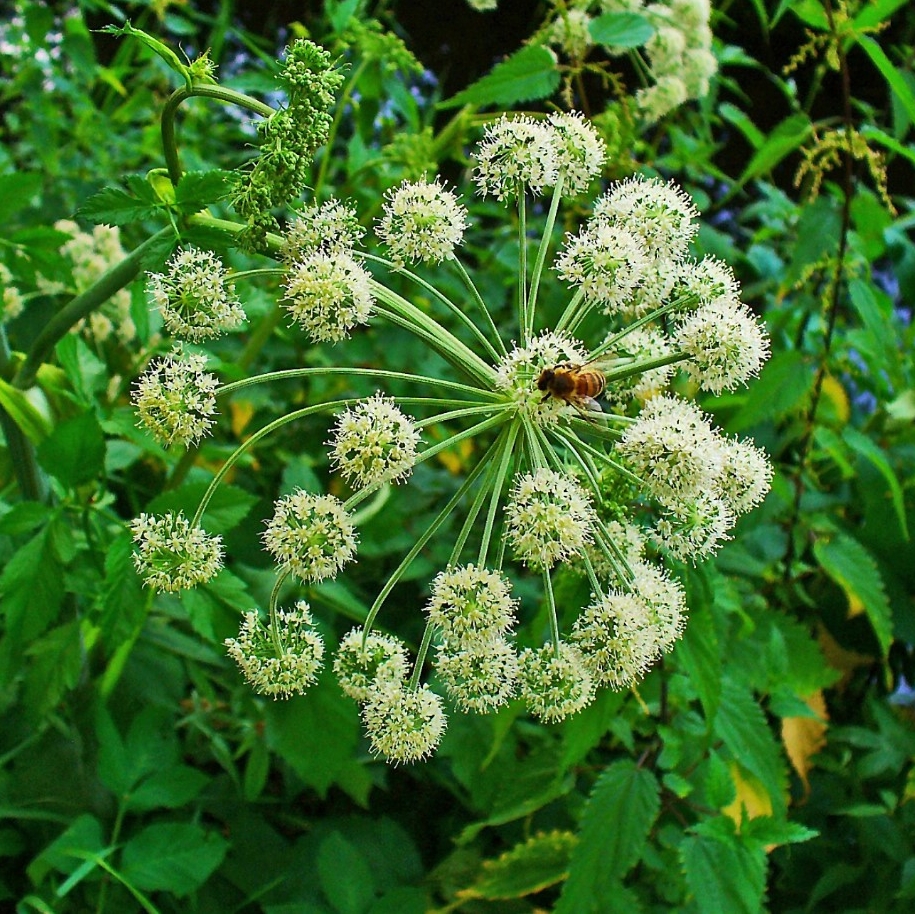Geographical Origin & Distribution
Angelica archangelica, commonly known as garden angelica, wild celery, or simply Angelica, is native to the northern regions of Europe and parts of Asia. Its geographical origin is primarily traced to the Nordic countries and regions with cooler climates.
Historical Use
Historically, Angelica has been valued for its medicinal and spiritual properties in Europe, especially in northern regions like Scandinavia. Its uses ranged from digestive and respiratory remedies to protection against plague and evil spirits. As European settlers arrived in America, they brought Angelica with them, where it became part of the early American folk medicine tradition. Although not as commonly used today, it remains a valuable herb in herbal medicine, aromatherapy, and natural remedies.
Medical Use
The plant is valued for its medicinal properties and has been used in traditional herbal medicine for centuries. The roots are primarily used for digestive and respiratory health, even though, other plant parts are equally used for medical purposes. Seeds, stems and leafs are used for digestive purposes, and as an essential oil, it offers relaxation and respiratory relief.
Leaves: Angelica’s leaves are large, with a triangular shape and deeply divided lobes. They can grow up to 90 cm long and are bright green.
Flowers: Angelica produces large umbrella-shaped flower clusters, known as umbels, that can be up to 30 cm in diameter. The small flowers are typically pale greenish-white or yellowish in color.
Fruit & Seeds: The fruits are small, flattened, and oval-shaped, measuring about 6-8 mm in length. Each fruit contains two seeds.
Roots: The roots are thick, fleshy, and can grow quite deep, making them one of the most valued parts of the plant in traditional medicine.
Size: It can grow to a considerable height, usually between 1.5 to 2.5 m, depending on growing conditions.
Native Regions: It is native to northern and eastern Europe, particularly in Nordic regions, but is also found in Asia.
Growing Conditions: Angelica prefers cool, temperate climates with cool summers. It is a biennial plant, meaning it typically lives for two years. In its first year, it primarily produces leaves, and in its second year, it flowers and dies after setting seeds. The plant thrives in moist, well-drained soils rich in organic matter and one finds the plant often near riverbanks, marshy areas and woodlands. It prefers slightly acidic to neutral pH levels.

Active Substances
- Essential Oils: α-Pinene, β-Phellandrene, Myrcene, and Limonene with anti-inflammatory, analgesic, and antimicrobial properties. These contribute to Angelica’s ability to help with respiratory issues, but also digestion.
- Coumarins: Bergapten withphotosensitizing properties, meaning it makes the skin more sensitive to sunlight. It also has anticoagulant effects, which can help improve circulation. Imperatorin, known for its antispasmodic and vasodilatory effect. Psoralen for skin treatments, and Xanthotoxin with anti-inflammatory and antibacterial properties , also used to treat skin conditions.
- Furanocoumarins: Oxypeucedanin with potential antispasmodic and antifungal effects, supporting its use in treating digestive and fungal conditions.
- Organic Acids: Caffeic Acid and Chlorogenic Acid as antioxidants with anti-inflammatory properties.
- Polyacetylenes: antifungal and antimicrobial properties.
- Sterols: anti-inflammatory properties.
- Flavonoids: Quercetin and Luteolin are well-known antioxidant and anti-inflammatory flavonoids.
- Angelicin: A furanocoumarin that exhibits anti-inflammatory and antibacterial effects.
- Tannins: astringent properties to help tighten tissues and reduce inflammation, aid in wound healing and support digestive health by reducing diarrhea.
Chemical Breakdown (per 100g of dried Angelica root)
Essential Oils: 0.5-1.0%
Coumarins: 0.3-0.5%
Furanocoumarins: traces
Phenolic Acids: Caffeic Acis 0.1%–0.3 mg, Chlorogenic Acid 0.5-1.0 mg
Flavonoids: 0.1-0.5 mg
Sterols: traces
Tannins: traces
Polyacetylenes: traces
Uses of Angelica root for Horses & Dogs
While Angelica root is generally considered safe for horses and dogs, some animals may react, resulting in a sensitivity to UV-light. It therefore important to introduce any new ingredient or supplement gradually and monitor your animal’s response. Don’t feed to pregnant mares or horses with acute stomach or intestinal ulcers!
- Respiratory Health
- It is often used to treat coughs, bronchitis, and other respiratory conditions by acting as an expectorant and clearing mucus from the lungs, as well as promoting easier breathing and reducing mucus buildup..
- Anti-inflammatory Properties
- Angelica root has anti-inflammatory compounds, which can be beneficial for horses with conditions like arthritis or laminitis. It may reduce pain and swelling in joints or tissues.
- In dogs, its anti-inflammatory effects can be helpful in managing joint pain, particularly in older dogs suffering from arthritis or other joint conditions.
- Digestive Health
- It may be used to support digestive health due to its anti-inflammatory and antispasmodic effects on the stomach and intestines. It may also help with gas-related issues in the intestines as it reduces and expels gas.
- Angelica root is known to stimulate the appetite.
- Immune Support
- Horses and Dogs: Angelica root contains compounds that boost the immune system by supporting overall health and vitality. Its antioxidant properties can help animals recover from illness or injury and maintain better health overall.
- Anxiety & Nervousness
- Angelica root may offer an antispasmodic effect for horses, which helps relieve muscle spasms or cramps, particularly useful for horses with colic or digestive distress.
- This property can also benefit dogs with muscle tension or digestive cramping.
Additional sources: National Center for Biotechnology Information; National Center for Biotechnology Information
